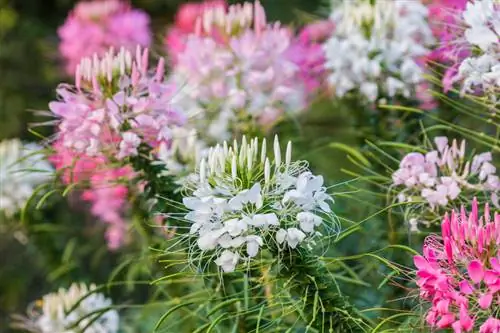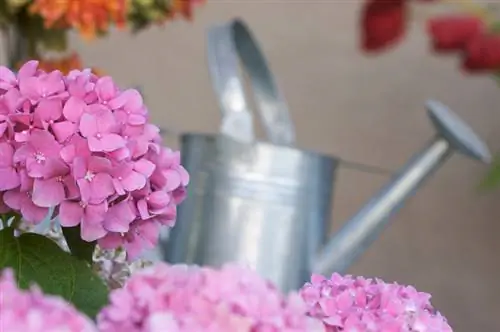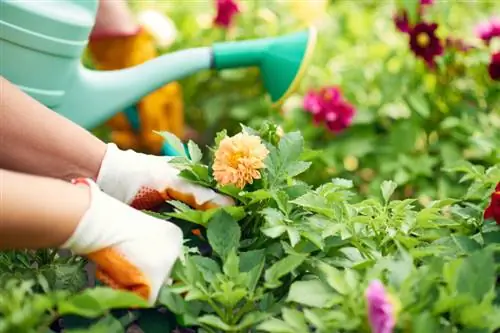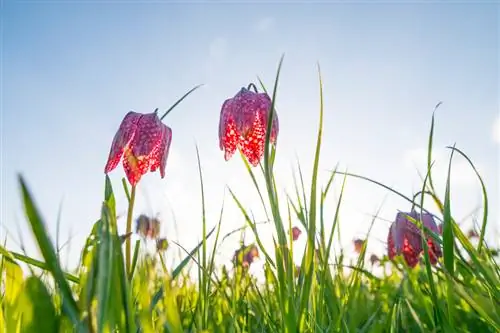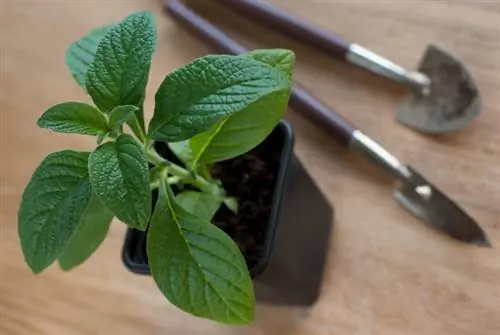- Author admin [email protected].
- Public 2023-12-25 17:45.
- Last modified 2025-01-23 11:20.
The scary name doesn't do justice to her elegant appearance. In fact, the annual spider flower enriches the summer garden with fragrant flower clusters and bushy, branched, majestic silhouette. The extra-long stamens, which from a distance resemble spider legs, give the flower clouds an extravagant look. The isolated thorns in no way detract from the picturesque Cleome. Read concrete answers to frequently asked questions about successful cultivation here.
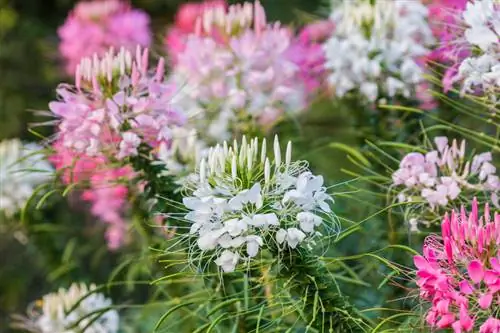
How to care for a spider flower?
The spider flower is a majestic annual plant with fragrant flower clusters and extra-long stamens. It prefers a sunny, warm location and well-drained, humus-rich soil. Care includes regular watering, fertilizing and removing wilted flowers.
Planting spider flowers correctly
The rise of the thermometer to clearly and permanently above 14 degrees Celsius signals the beginning of the planting time for the spider plant. Before you start preparing the soil in a sunny, warm location, place the potted root ball in water. If the Cleome does not function as a solitary plant, but rather creates decorative accents as a group, please create the appropriate number of planting pits at a distance of 30-40 cm. A third of the excavation is optimized with compost and horn shavings. Plant the now potted spider flower so deeply that the soil reaches the bottom pair of leaves so that it can be watered generously.
Care tips
Their floral opulence belies the low demands. In truth, the spider plant is so modest that it makes gardening life easy for even beginners. How to properly care for a Tarenaya hassleriana:
- Water abundantly and regularly until the soil no longer absorbs water
- Only water again when the substrate has dried out
- Fertilize weekly from July to October or apply a slow-release fertilizer every 3 months
- On non-sterile varieties, regularly cut off the withered flowers
If you leave some withered flowers in the bed in summer, the spider flower will take care of the propagation by self-sowing. When the cold season begins, the plants die and are disposed of in the compost.
Which location is suitable?
Given its South American origins, the only possible location is in full sun, warm and sheltered from the wind. In front of the south wall of the house, along the garden fence or as a backdrop plant in the sunny perennial bed, the spider plant creates floral abundance where other plants would languish. The soil should be correspondingly warm, nutrient-rich, humic and well-drained.
The correct planting distance
In crowded conditions, the majestic appearance falls by the wayside. Therefore, give a spider plant enough space to develop unhindered. With a planting distance of 30 cm for the medium-sized varieties and 40 cm for the large beauties, you are exactly right. In the bucket or balcony box, reduce these values by 5-8 cm.
What soil does the plant need?
The spider plant once again demonstrates its undemanding frugality when it comes to soil conditions. The spirited summer flower thrives in any good garden soil that is humus, fresh, moist and rich in nutrients. Deciding on the suitable potting substrate is therefore easy, as commercially available potting soil with a low peat content easily meets expectations. If in doubt, add some sand or perlite for best permeability.
What is the best time to plant?
For the spider plant, the start of the planting time is not based on a calendar date. Instead, the thermometer determines when the outdoor season begins for a Cleome. Only put the summer flower in the bed or on the balcony when the temperatures consistently exceed 14 degrees. Experience has shown that the weather settled at this level of warmth at the end of May/beginning of June.
When is flowering time?
Three to four weeks after planting, the spider plant unfolds its orchid-like flowers with distinctive stamens. Where the light and temperature conditions are right, the colorful spectacle extends from July to October. Hobby gardeners who are short on time will be pleased to note that the red and white varieties Senorita Rosalita (Fesche Fanny) do not require laborious cleaning out of wilted flowers. On all other varieties, please regularly cut off spent heads so that new flowers grow instead of the energy-sapping seed heads.
Cut spider flower correctly
Pruning measures on a spider plant are limited to the continuous removal of withered flowers. Your effort will be rewarded with a tireless display of flowers from July to October. Otherwise, a cleome will produce capsule fruits, at the expense of new flowers. The only exceptions are the two sterile varieties Senorita Rosalita and Senorita Blanca. There is no need for cutting here as no seed heads develop here. Since the tightly upright summer beauties are ideal for the vase, cut freshly bloomed stems hand-width above the ground. As long as one or two leaves remain on the plant, it will sprout again.
Watering spider flower
The spider plant evaporates moisture every day in a sunny spot through its dense leaves and flowers. This water loss is compensated for by regular watering so that drought stress does not occur. Please apply the water immediately to the root disc until the soil no longer absorbs moisture. On potted flowers, the first drops in the saucer signal that the current water requirement has been met. On hot summer days, it may be more common for you to water your Cleome in the pot or balcony box twice a day - in the early morning and in the evening.
Fertilize spider flowers properly
The nutrient reserves that a spider plant received during planting are used up within 4 weeks. Now it's important to give fertilizer regularly so that the magnificent summer flower doesn't run out of energy. From July until the end of the flowering period, please administer a liquid fertilizer for flowering plants every week at a dosage of 2 grams per liter of irrigation water. Alternatively, a cleome receives a slow-release fertilizer, such as Osmocote, in July and September. Furthermore, a mulch layer of leaves or grass clippings provides a permanent supply of nutrients that are prepared for the roots by busy soil organisms.
Wintering
In view of its pronounced sensitivity to cold, there is no prospect of a he althy overwintering for the spider plant. The minimum temperature of 14 degrees Celsius nips ambitious plans in this regard in the bud. Instead, simply collect the capsule fruits to use the seeds for propagation.read more
Propagate spider flower
If you leave a few withered flowers in the bed, the spider plant will produce capsule fruits and sow itself. In order to direct propagation in the desired direction, you can collect these seed heads, dry them and store them in a cool place until next spring. In March, sow the seeds in small pots or a tray. Sieve the light germinators with sand or vermiculite to a maximum depth of 5 mm and moisten with a fine spray. Germination takes 3 weeks in a partially shaded window seat at temperatures of 18-20 degrees Celsius. Please note that germination does not occur at temperatures below 14 degrees. Before you plant out the young Cleomes at the end of May/beginning of June, we recommend hardening them off on the balcony for 8 days to gradually get them used to the sun and fresh air.
Spider flower in a pot
With its extravagant flowers and proud posture, the spider plant attracts everyone's attention on the balcony and terrace. How good that the South American summer beauty is just as undemanding when grown in pots as it is in beds. We have summarized all the important criteria for you here:
- Potter shards or grit above the floor opening act as protection against waterlogging
- Peat farms enrich potting soil with perlite, lava granules or pumice for good permeability
- Water regularly when the substrate has dried on the surface
- Fertilize weekly from July to October or apply a slow-release fertilizer
If withered flowers are cleaned out every few days, the cleome does not invest its energy in growing seed heads, but tirelessly produces new flowers.
Is spider flower poisonous?
Their botanical classification as cruciferous plants makes us pay attention because these plants are generally poisonous. Unfortunately, the spider plant is no exception. The toxic alkaloids and glycosides are concentrated in the seeds, but are also contained in the leaves and shoots. The sterile varieties Senorita Rosalita and Senorita Blanca are therefore ideal for cultivation in the family garden, as the questionable capsule fruits do not develop here. However, wear gloves during all planting and care work, as the plant sap can cause allergic reactions if it comes into contact with the skin.read more
Spider flower not blooming
If a spider plant refuses to flower, one or more factors are causing its displeasure. Therefore, put the framework conditions to the test in order to take possible improvement measures. We have put together the most common causes for you here with tips on how to fix them:
- Lack of light: Place the flower in a full sun location
- Waterlogging: Only water when the soil surface has dried; Transplant potted flowers into dry substrate
- Nutrient deficiency: Add liquid fertilizer (€14.00 on Amazon) to the irrigation water weekly from July to October
By far the most common cause of failure to bloom is cold. As long as summer denies us warm temperatures of more than 14 degrees Celsius, you will look in vain for the magical flowers on a Cleome. In this case, continue the care program as planned. As soon as the mercury column rises, the spider flower puts on its flower dress.
Beautiful varieties
- Helen Campbell: Majestic spider plant with white, fragrant flowers; the ideal backdrop plant; 120cm
- Cherry Queen: Elegant variety that surprises with cherry-red flower clusters; very beautiful as a cut flower; 100-120cm
- Spider: Magnificent mix for a colorful flower bed, in front of fences and in pots in white, pink and pink; 80-90cm
- Senorita Rosalita: Award-winning Cleome with pink-purple, orchid-like flowers for beds and balconies; 50-60cm
- Senorita Blanca: The white-flowering counterpart to Rosalita, both of which harmonize perfectly; 50-60cm

